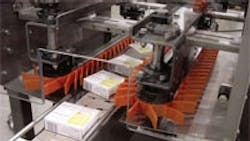Round, flat, and vee urethane belts are often used in reciprocating applications. Reciprocating diverter belts pop up between conveyor rollers to sort music CDs by pushing some to the left, and some to the right. Urethane belts are also found on roller conveyors that move products back and forth between workstations. Too, these belts are found on reciprocating pumps used in medical applications — the Playtex Breast Pump is one example.
Advantages: Elastic belts need no belt tensioner; this can greatly reduce an application's cost. • Round belts work on misaligned pulleys, so they are well suited for mass produced products. • They're very inexpensive — probably the lowest in cost of all belting alternatives. • Custom sizes are available very quickly, in a few days, with no tooling charges. • They're USDA/FDA approved as food-grade. • Urethane belts are oil and abrasion resistant, non-marking, and with the addition of an inexpensive tracking sleeve, flat belts track on rollers (so they don't walk sideways) without need for flanges, grooves, or vee guides.
Disadvantages: Urethane belts are not suited for moving extremely heavy loads or high-precision applications; timing belts are recommended here. • Even high-temperature urethane belts are not suited for above 230°F. • Flat urethane belts need crowned pulleys to track — but they will not track unless the pulleys rotate at least three times in the same direction. Round and vee belts do not have this problem.
Reversing load does affect the dynamic limits of a belt. Urethane belts are elastic, so they stretch and slip if heavy loads are accelerated or decelerated too quickly. Fortunately, they “tell” you when they are being overstressed, with squeaking. It is best to come to a complete stop before changing directions: Because urethane belts have a high coefficient of friction on steel, aluminum, and plastic pulleys, slipping can cause them to abrade or overheat, which may lead to premature failure. However, it takes a lot of force to make them slip.
For non-endless oscillation, open-ended, unjoined belting cord or sheets can be clamped on the ends, so that they can be pulled back and forth.
For more information on urethane belts, visit durabelt.com or call (614) 777-0295. With chain questions, visit renoldjeffrey.com or call (800) 251-9012.
Working on the chain gang
We consulted Mike Barlow, applications engineer at Renold Jeffrey, Hebron, Ky., for the specifics on using chain in reciprocating applications. Here's what he had to say.
How (dynamically) are reciprocating applications unique?
With rotational applications, chain is normally subjected to constant running. As such, on startup, the chain sees one acceleration and one dynamic load due to acceleration. It also sees one deceleration until the system comes to rest. Chain is subjected to dynamic and centrifugal forces when running at high speed.
In reciprocating applications, the chain is always subjected to high dynamic forces from acceleration and deceleration. If there is backlash or slack in the system, sprocket engagement results in additional shock loading. A common example of an oscillating application is the use of leaf chain on forklift trucks. Other examples are dam gates, other lift gates, or counterbalance systems.
How does reciprocation affect chain limits?
Once a rotational drive is running, the chain can be classified as a steady-state application. In comparison, a reciprocating drive is a highly impulsive drive. Also, wear that's present on a rotational drive is spread equally throughout the chain. On the other hand, on a reciprocating drive, chain exhibits areas of localized wear in the articulating section.
What is the best way to arrange chain?
In an oscillation application, the chain should be fixed to a shackle on one end, wrapped around a sprocket or pulley, and then anchored at the other end by means of an adjustable shackle. The shackle aids in chain tensioning. Motion can be applied through the chain by means of a pneumatic or hydraulic cylinder.
